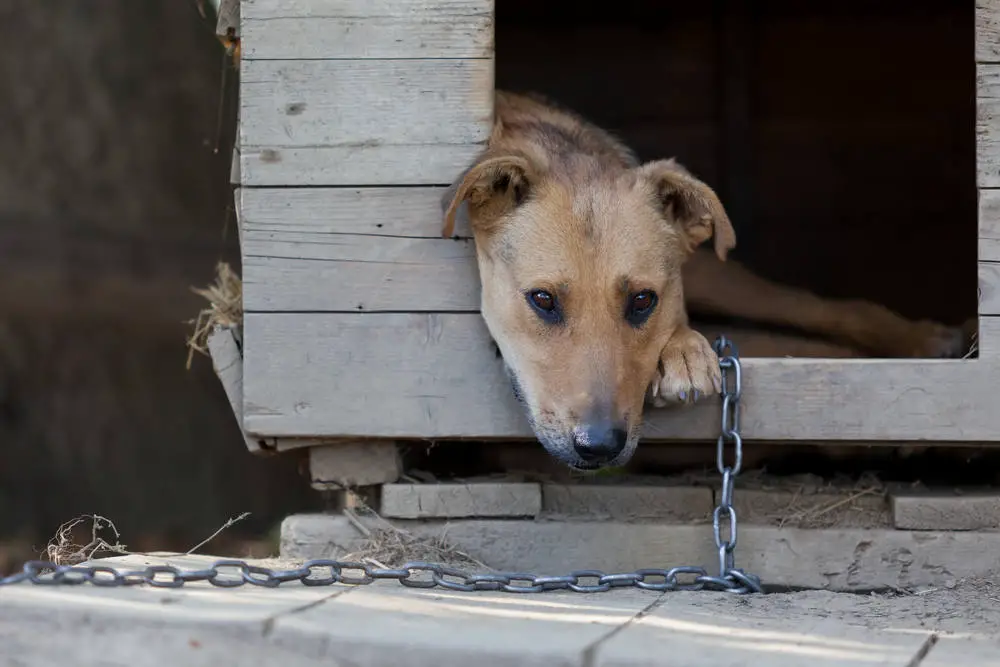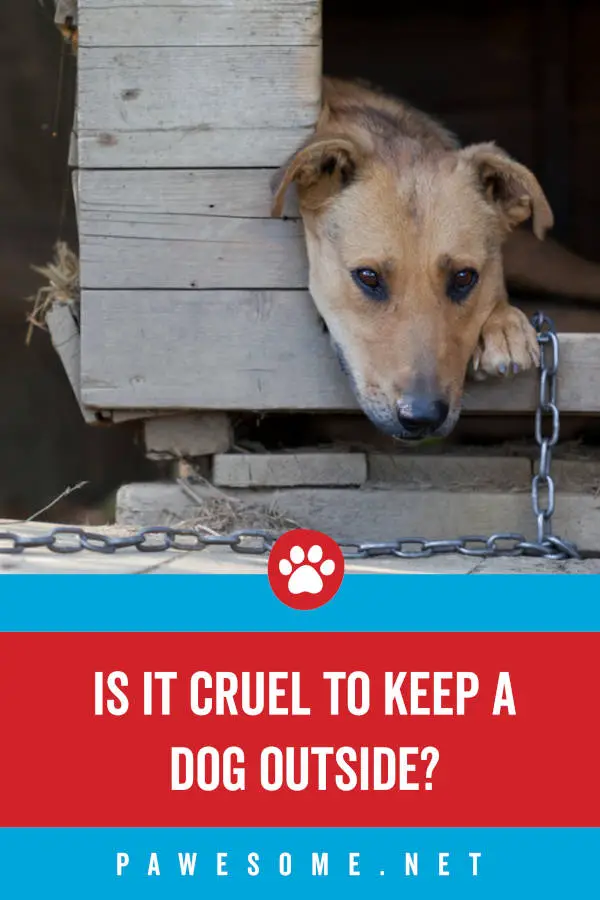 Sadly, it’s all too common to chance upon dogs tethered outside the house. It does make you wonder why people even get pets in the first place if they’re only going to leave them tied outside the whole time, come rain, snow or sunshine!
Sadly, it’s all too common to chance upon dogs tethered outside the house. It does make you wonder why people even get pets in the first place if they’re only going to leave them tied outside the whole time, come rain, snow or sunshine!
But leaving aside the “humaneness” factor, is it really cruel to keep a dog outside?
Inside vs Outside
It wouldn’t be an exaggeration to say that this is one of the most debated topics among pet parents and non-pet parents alike, with lots of accusations flung from both sides!
Those who say that pets should be kept outside argue that it’s healthy for them and lets them enjoy their freedom, while the opponents argue that it’s cruel and inhumane to do so.
There’s also that one group, somewhere in between, that thinks keeping dogs outside is a good way to punish them for any bad behavior!
As it turns out, both arguments have their merits and both arguments are backed by truth—some dogs thrive in the great outdoors while some are content with the occasional walk.
Of course, when we’re talking about keeping a dog outside, it means comfortably, with a well-built kennel that can be fitted to be compatible with different seasons and climatic conditions; we are not talking about keeping dogs chained out in the yard, exposed to the elements’ mercy, or even worse, locked up in tiny cages and crates in the backyard.
However, much as your dog enjoys being outdoors, the fact remains that forcing a dog to live outdoors through the year is not just unkind, but also extremely unhealthy, and for more reasons than just weather conditions. Read on for clarity on whether or not you can keep a dog outside and if yes, when it is okay to do so!
What Breeds Can Be Kept Outside?
Guard Dogs
Some dog breeds, such as livestock guard dogs, don’t mind living comfortably in your backyard—this includes dogs such as Komodors, Pyrenees, Ovcharkas and other guard dogs.
These dogs do like the occasional trip indoors, till they have to go back outside to fulfill their guard dog duties, but forcing them to stay indoors could adversely impact their health.
Furry Dogs and Sled Dogs
Similarly, furry sled dogs with thick coats can also live in your backyard, such as Malamutes, Siberian and Alaskan Huskies and Samoyeds.
However, that doesn’t mean that it’s okay to leave such dogs in the backyard during a hot, dry Californian summer and expect them to be okay; it’s okay to leave them outside during the cold winter as they’re genetically equipped for this, but if your pup has adapted to living indoors and spent the majority of his life living indoors, you don’t need to and shouldn’t put him out during the winter months.
Many sled dogs in the Arctic regions are kept outside and are still healthy enough to pull sleds for long distances, so it makes sense to conclude that these dogs aren’t being abused by being kept outside.
Shepherds
Additionally, sheep-herding dogs are also outdoor dogs, with shaggy coats meant to withstand tough weather conditions; give them a nice shelter and they’re quite happy to live outdoors, as are Bernese Mountain Dogs, Saint Bernards, Tibetan Mastiffs and Newfoundlands.
However, remember that these dogs are comfortable outside only in conditions that are suited to them. This means, as mentioned earlier, you can’t put a Husky outside in the blazing hot summer or a Chihuahua in the freezing winter and expect them to thrive.
Therefore, when in doubt, it’s okay to generalize based on the breed’s physical characteristics.
Additionally, bear in mind that if you’ve raised your Husky to be an indoor dog but someone tells you that he’s meant to be an outdoor dog, trying to put him outside is more harmful than helpful to him.
You’re taking a dog that’s meant for the cold, training him or her to become used to the ambient weather inside your house and then forcing him or her to go back out!
Thus, also consider what the dog has adapted to and most importantly, what your dog prefers (and your dog will very clearly indicate what he or she prefers).
What Breeds Should Be Kept Inside?
Generally, small or medium-sized dogs are indoor dogs, especially those with short coats and under 21 pounds. This includes Maltese, terriers, and Chihuahuas—they can freeze to death even with a great kennel/dog house.
Things to Keep in Mind If You Have an “Outdoor Dog”
Making Your Doggo Comfortable
If you’re putting your dog outside, it should be because your dog is built for the outdoors and more importantly, is adapted to it and enjoys it. Constantly shuttling your pupper indoors and outdoors can be harmful if he or she has adapted to one particular environment.
If you want to keep your dog outside, because he or she loves it, remember to make the setting comfortable—a well-built kennel or shelter, sufficient food and water, and enough social connection; this means that you don’t leave your dog outside and forget about him or her.
At the end of the day, it should be remembered that dogs are highly social animals. Once you get a dog, you and your family become his pack. Constantly visit your little ball of fur, play with him, ensure he has favorite toys with him and most importantly, do not tether or chain him!
Behavioral Issues
Additionally, putting your dog outside as a means of punishing him or her is highly not recommended. This can be extremely cruel and inhumane. Try to resolve any issues with the vet or canine behaviorist.
Most times, leaving your dog outside as a means of punishment for bad behavior is counter productive; it can actually instigate more bad behavior, such as incessant barking, digging up holes around the backyard, chewing anything and everything they can find and even becoming hostile and aggressive.
Suited to Your Lifestyle
Last but definitely not the least, pick a dog that’s suited to your lifestyle, if you’re planning to get a dog.
Don’t get a furry dog if you hate hair on the furniture. If someone in the house is allergic to long-haired dogs, simply don’t get one! If you don’t have time or space for an energetic dog, don’t get an energetic dog!
It isn’t fair to either party; none of these reasons are good enough to get a dog only to leave the poor thing chained outside. All it indicates is that you, as a pet parent, are unwilling or incapable of raising your pet right, just as a child’s bad behavior reflects on his or her parents.
Oh, and did we mention that animal neglect is punishable by law in all 50 states, with some states even levying felony penalties on such cases?
The Bottomline
Long story short, there is no hard and fast rule when it comes to keeping your dog outside, neither is it always cruel. It’s only cruel if you’re forcing your dog to do it or have the wrong motivation or intention behind leaving your dog outdoors. Therefore, always consider your dog’s genetic make up, what he or she has adapted to, and most importantly, what he or she likes!

